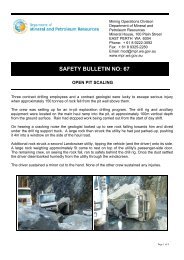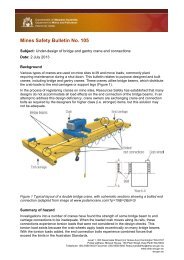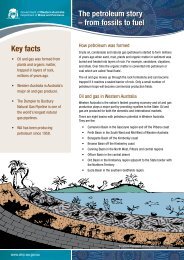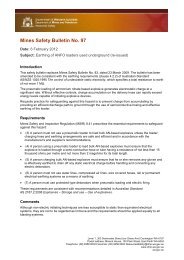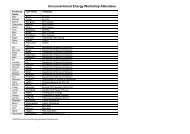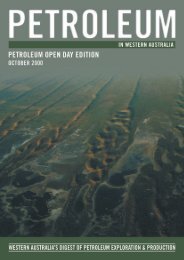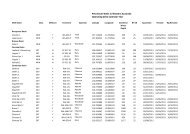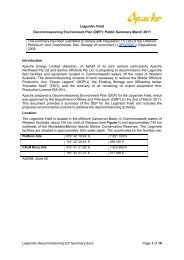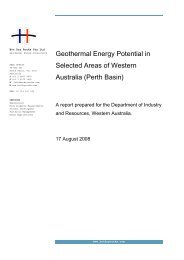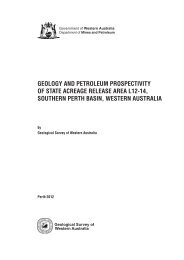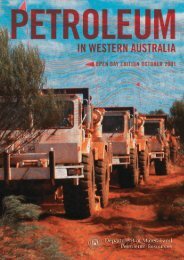Phase III - Department of Mines and Petroleum
Phase III - Department of Mines and Petroleum
Phase III - Department of Mines and Petroleum
You also want an ePaper? Increase the reach of your titles
YUMPU automatically turns print PDFs into web optimized ePapers that Google loves.
opposed to the 10 samples recommended by the American Society for Testing <strong>and</strong> Materials) suggest that<br />
the variability in tensile strength <strong>and</strong> S Hmax will not be fully represented in the results.<br />
The stress regime beneath Barrow Isl<strong>and</strong> is now considered more likely to be normal (S hmin < S Hmax < S v ),<br />
rather than strike slip (S hmin < S v < S Hmax ), with S Hmax trending approximately E-W, which is consistent with<br />
the regional neotectonics. The change in interpretation <strong>of</strong> the stress regime resulted from the decrease in<br />
S Hmax from pre- to post-Data Well.<br />
The GJV should consider using Chevron’s GeoMechanical_Reservoir Simulator (GMRS) code to conduct<br />
reservoir-geomechanical simulations to better underst<strong>and</strong> the stress path that will be followed during CO 2<br />
injection <strong>and</strong> use those results to conduct a series <strong>of</strong> triaxial tests to confirm the behaviour <strong>of</strong> the Dupuy<br />
Massive S<strong>and</strong> formations. Reservoir-geomechanical simulations will also provide insight into whether the<br />
pore volume change under shear will have a positive or negative impact on injectivity.<br />
Geomechanical Impact on Seals<br />
Injection <strong>of</strong> CO 2 has the potential to produce local <strong>and</strong> regional over-pressurisation <strong>of</strong> the reservoir <strong>and</strong><br />
surrounding rock. Such increases <strong>of</strong> pressure decrease injectivity <strong>and</strong> effective permeability while<br />
elevating the likelihood <strong>of</strong> fracture generation <strong>and</strong> reactivation <strong>of</strong> fault slip. The possibility <strong>of</strong> local overpressurisation<br />
occurring is dependent on a number <strong>of</strong> factors including; i) pre-injection stress conditions in<br />
the reservoir, ii) rate <strong>of</strong> injection, iii) permeability <strong>of</strong> the injection reservoir <strong>and</strong> iv) the depth <strong>of</strong> the<br />
injection point from the base <strong>of</strong> the seal.<br />
Over-pressurisation <strong>of</strong> a reservoir into which CO 2 is being injected is not desirable where it significantly<br />
reduces injectivity <strong>and</strong> produces new fractures <strong>and</strong>/or reactivation <strong>of</strong> slip on existing faults. Predictions <strong>of</strong><br />
slip on existing faults are expressed in terms <strong>of</strong> the differential (i.e., increase relative to pre-injection)<br />
pressure that can be exerted on the reservoir or seal rocks before failure is likely. The formation <strong>of</strong> new<br />
fractures, most likely close to injection wells, can be induced by pressure <strong>and</strong>/or temperature changes<br />
arising from CO 2 injection. The effect <strong>of</strong> CO 2 injection on reservoir pressure, <strong>and</strong> the possible impact this<br />
may have on containment have been examined.<br />
The differential pressure, or critical delta pressure, has been assessed by GeoMechanics International<br />
(GMI) for the Main Barrow, Godwit, Plato, Triller, P18J <strong>and</strong> U22J faults. The critical delta pressure is<br />
partly dependent on the co-efficient <strong>of</strong> friction assigned to each fault. Our analysis <strong>of</strong> the critical delta<br />
pressures presented in the GMI geomechanics report, in combination with the assumption that certain faults<br />
(i.e., Main Barrow, Godwit <strong>and</strong> Triller faults) are not predicted to intersect the CO 2 plume, suggests that<br />
slip on these faults (i.e., Main Barrow, Godwit, Plato, Triller, P18J <strong>and</strong> U22J faults), induced by increases<br />
in pore pressure due to injection <strong>of</strong> CO 2 beneath Barrow Isl<strong>and</strong>, is unlikely to elevate the risk to CO 2<br />
containment.<br />
Rock strength measurements <strong>and</strong> analysis <strong>of</strong> the stress data indicate that fracturing initiated in the Upper<br />
Massive S<strong>and</strong> could grow preferentially in the overlying seal. Our analysis <strong>of</strong> the stress changes expected<br />
to occur in the Upper Massive S<strong>and</strong> during injection also suggests that shear failure (i.e., stress conditions<br />
that satisfy the Mohr Coulomb failure criterion) could occur in this unit. Continued investigation is<br />
suggested on the potential for shear failure in the reservoir <strong>and</strong> seal, <strong>and</strong> should include reservoirgeomechanical<br />
simulations to fully underst<strong>and</strong> the stress changes within the reservoir <strong>and</strong> to estimate the<br />
magnitude <strong>of</strong> potential stress changes within the seals.<br />
Operational aspects <strong>of</strong> the CO 2 injection process include the limitation <strong>of</strong> bottom-hole pressure to avoid<br />
fracturing close to the injection wells, <strong>and</strong> the possible use <strong>of</strong> pressure relief wells. The GJV currently<br />
expects to have 675 psi <strong>of</strong> working pressure available when injection commences. We anticipate the<br />
impact <strong>of</strong> mechanical <strong>and</strong> thermal effects in the determination <strong>of</strong> the maximum bottom-hole pressure will<br />
come under further scrutiny. The Due Diligence Team supports the use <strong>of</strong> pressure-relief wells as a<br />
mitigation strategy <strong>and</strong> encourage the GJV to use coupled geomechanics <strong>and</strong> fluid flow simulators for the<br />
prediction <strong>of</strong> post-injection reservoir pressures.<br />
xxvii



